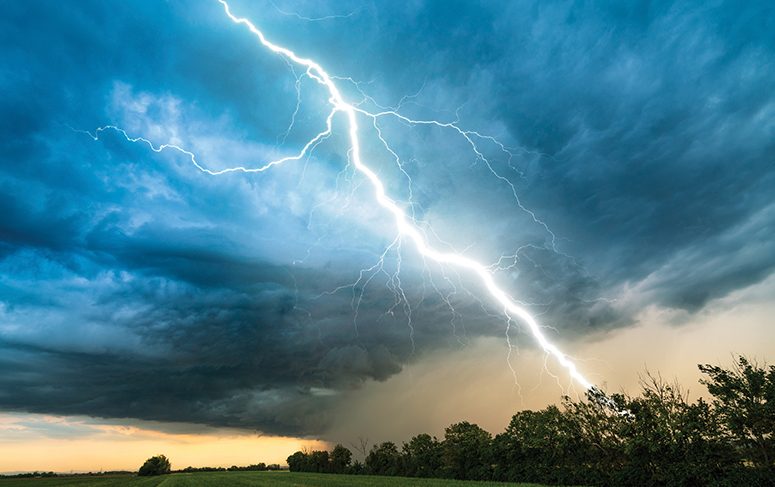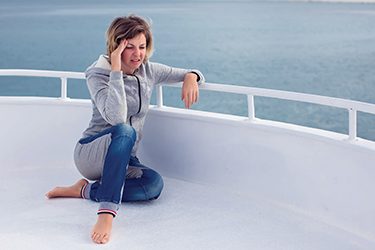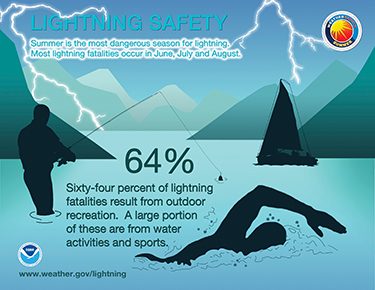OTHER EXPOSURE CONCERNS:
DEHYDRATION, LIGHTNING, SUNBURN,
POISON IVY, OAK, AND SUMAC

The opportunity to enjoy the scenic splendor of the great outdoors is one of the major attractions of traveling, but it comes with a risk of injury due to exposure. The following are some of the primary dangers.
While this guide cannot detail all possible sources of exposure-related injuries, the following are a few other serious or common problems.
Dehydration
Dehydration occurs when the body’s level of water and other fluids falls below normal. Humans lose water through sweating, breathing and waste elimination. Medical problems that cause vomiting, diarrhea, edema or bleeding markedly increase this loss.
Symptoms: Even mild dehydration can result in poor judgment, weakness, headache and lack of energy; it can also make people more susceptible to infections, hyperthermia or decompression illness. Marked dehydration can cause imbalances in electrolytes (salts and other minerals in blood and other body fluids).
Individuals suffering from dehydration may also have a loss of elasticity in their skin, excessively dry mucous membranes (in the nose and throat, for example) and urine output that darkens in color and declines in quantity. If you have been swimming or diving, however, your first urine output after immersion may be clear even if you are dehydrated, which is due to immersion diuresis — that is, an increased production of urine during immersion due to vasoconstriction (narrowing of the blood vessels), which results in your urine being more diluted than it would be otherwise.
Dehydration is often suspected when someone feels unwell after having been physically active and sweating profusely in a hot, humid environment. The condition is much more difficult to detect in cooler environments, where an individual’s fluid intake still may not keep up with the loss of body fluids. Dehydration in such conditions can be gradual; victims may not be aware of their depleted state until an emergency arises, which can be especially dangerous if they are traveling in a remote area.
Treatment: Treatment of dehydration involves replacing the lost fluids and electrolytes — orally in cases of mild to moderate dehydration but intravenously in more severe cases. Administering frequent, small amounts of water is the best approach.
Prevention: Travelers in hot and humid environments may need to increase their fluid intake beyond the recommended 8 cups (almost 2 liters) of water per day. Don’t restrict your salt intake when traveling in such climates, because the loss of salts during prolonged exposure to heat and humidity may result in hyponatremia, which is characterized by abnormally low levels of sodium in the blood and can cause lethargy, headaches, seizures and even death if the brain swells due to ingestion of water but not enough salts and other electrolytes. This does not mean you should drink salt water, which can cause more dehydration. Studies of shipwreck survivors demonstrate that those who survived were those who refrained from drinking salt water.
Lightning
The Earth receives an estimated 100 lightning strikes per second, so it is not surprising that lightning sometimes strikes humans. The U.S. National Weather Service reports there were 20 fatalities from lightning strikes in the U.S. in 2019 and 17 fatalities in 2020.49 Worldwide estimates of lightning fatalities range from 6,000 to 24,000 cases per year.50 An individual’s lifetime odds of being killed by lightning are 1 in about 15,300.51
The CDC recommends the following strategies to avoid being struck
by lightning:
- Check the weather forecast before leaving for an outdoor excursion.
- If you hear thunder, seek shelter in an enclosed building or a hard-topped vehicle with the windows rolled up. Avoid open structures or vehicles such as porches or golf carts.
- Avoid ridgelines, mountain summits and isolated trees or other tall items such as power poles. If you are in the woods, stay near shorter trees.
- Stay away from water such as swimming pools, ponds, rivers and
even puddles. - Avoid tall structures.
- Avoid contact with anything metal. If you are in a concrete structure, avoid leaning against the walls, because lightning can travel through the metal reinforcement in concrete.
- Do not wear or carry anything metal.
- If you are in a group, separate from each other.
If lightning strikes you or someone with you, immediately call for emergency medical assistance and then take the following steps:
- Minimize the risk of further strikes, and move the victim to a safer location if necessary.
- Check to see if the victim is breathing and has a heartbeat. If not, immediately start chest compressions. Initiate rescue breathing if anyone in your group has CPR training. For more information about performing chest compressions and administering CPR, see Administering CPR in Section 6.
- Continue chest compressions and CPR until medical personnel arrive.
- Assess the victim for other injuries such as burns or blunt trauma, and administer first aid as possible and appropriate.
- If there is risk of hypothermia, place an insulating layer between the victim and the ground.
Sunburn
The depletion of the Earth’s ozone layer has made sunburn an increasingly common hazard of outdoor activities. The National Cancer Institute reports that 35 percent of adults and 57 percent of adolescents in the U.S. get at least one sunburn a year.52 The risk of melanoma, the most serious form of skin cancer, doubles after five or more blistering sunburns. Prevention is much more important than treatment.
The Skin Cancer Foundation provides the following tips for avoiding sunburn:
- Stay in the shade or indoors, especially between 10 a.m. and 4 p.m. and particularly in tropical and polar latitudes and at high altitudes.
- Use a sunscreen with a sun protection factor (SPF) of at least 15 for short intervals in the sun and 30 or higher for longer periods or when the sun is strongest. Apply it liberally to all exposed skin 30 minutes before going outdoors, and then reapply it every two hours. Use eco-conscious sunscreen without ecosystem-harming chemicals.
- Wear sun-protective clothing, including a broad-brimmed hat and sunglasses that block ultraviolet (UV) radiation.
- The sun reflects off water, sand or snow, increasing the intensity of the UV rays.
- You can get a sunburn on a cloudy day; some cloud formations can magnify the effect of the sun’s UV rays.
- Do not use tanning booths.
- Do the following if you get too much sun:
- Take a cool shower or bath.
- Apply moisturizing lotion.
- Stay well hydrated.
- Consider using a pain reliever such as ibuprofen (Advil)
if the sunburn is painful. - Seek medical attention if a blistering sunburn covers
more than 20 percent of your body.
It is a good idea to check your skin for unusual moles or other signs of potential skin cancer at least once a month.
Poison ivy, oak and sumac: Poison ivy, oak and sumac are the most common contact-poisonous plants in the United States, but there are others within the U.S. and elsewhere around the world. Learn to recognize the leaves of noxious plants to avoid the misery of the highly itchy rashes they can cause. For information about identifying poison ivy, oak and sumac, see CDC.gov/Niosh/Topics/Plants. Before you engage in wilderness activities in other parts of the world, research what plants to avoid there.
Exposure to urushiol, the natural chemical that causes the allergic rash, is possible by direct contact with the plant, indirect contact with a surface that has touched the plant or inhalation of particles from burning plants that contain the substance.
The CDC recommends the following steps for avoiding contact with such plants:
- Cover up: Wear long sleeves, long pants and gloves.
- Consider using a barrier lotion containing bentoquatam, but such lotions must be washed off and reapplied twice a day.
- Use rubbing alcohol (isopropanol or isopropyl alcohol) or soap and water to clean any gear that may have come in contact with such plants. Urushiol can remain potent on the surface of objects for up to five years.
- Do not burn plants that may contain urushiol or similar substances.
If despite your best efforts you come in contact with poisonous plants, the CDC recommends the following steps:
- Immediately wash the area well with rubbing alcohol, a specialized plant wash or a degreasing soap (such as dishwashing liquid) and lots of water, and then rinse well.
- Scrub under your nails with a brush.
- If you have a blistering rash, apply wet compresses, calamine lotion or hydrocortisone cream to mitigate the itching. An oatmeal bath or oral antihistamines such as Benadryl may also relieve itching.
- Seek medical attention in cases of a severe allergic reaction or severe itching or blistering.

Dehydration is much more difficult to detect in cooler environments, where an individual’s fluid intake still may not keep up with the loss of body fluids. Dehydration in such conditions can be gradual; victims may not be aware of their depleted state until an emergency arises, which can be especially dangerous if they are traveling in a remote area.

The Earth receives an estimated 100 lightning strikes per second.

The risk of melanoma, the most serious form of skin cancer, doubles after five or more blistering sunburns. Prevention is much more important than treatment.

Learn to recognize the leaves of noxious plants to avoid the misery of the highly itchy rashes they can cause.
DAN Customer Service
Mon–Fri, 8:30 a.m. – 5 p.m. ET
+1 (919) 684-2948
+1 (800) 446-2671
Fax: +1 (919) 490-6630
24/7 Emergency Hotline
In event of a dive accident or injury, call local EMS first, then call DAN.
24/7 Emergency Hotline:
+1 (919) 684-9111
(Collect calls accepted)
DAN must arrange transportation for covered emergency medical evacuation fees to be paid.
Medical Information Line
Get answers to your nonemergency health and diving questions.
Mon–Fri, 8:30 a.m. – 5 p.m. ET
+1 (919) 684-2948, Option 4
Online: Ask A Medic
(Allow 24-48 hours for a response.)